Experimental Study of Light Propagation in Apple Tissues Using a Multispectral Imaging System
Abstract
:1. Introduction
- Develop a multispectral optical bench devoted to steady-state backscattering imaging of food and agricultural products,
- Characterize the image sizes, light profiles, and classify samples by means of established dimensionless parameters, and
- Assess the optical parameters of unpeeled and peeled apples, using an appropriate fitting algorithm.
2. Materials and Methods
2.1. Setup and Tissue Arrangements
2.2. Apple Samples
2.3. Data Processing
2.4. Diffusion Model
3. Results and Discussion
3.1. Backscattering Data
3.2. Transmittance-Reflectance Mode Data
3.3. Comparative Analysis of Dimensionless Parameters
3.4. Assessment of Optical Properties
4. Conclusions
Acknowledgments
Author Contributions
Conflicts of Interest
References
- Brown, G.; Segerlind, L.; Summitt, R. Near-infrared reflectance of bruised apples. Trans. Am. Soc. Agric. Eng. 1974, 17, 17–19. [Google Scholar] [CrossRef]
- Mollazade, K.; Omid, M.; Tab, F.A.; Mohtasebi, S.S. Principles and Applications of Light Backscattering Imaging in Quality Evaluation of Agro-food Products: A Review. Food Bioprocess Technol. 2012, 5, 1465–1485. [Google Scholar] [CrossRef]
- Nicolaï, B.M.; Beullens, K.; Bobelyn, E.; Peirs, A.; Saeys, W.; Theron, K.I.; Lammertyn, J. Nondestructive measurement of fruit and vegetable quality by means of NIR spectroscopy: A review. Postharvest Biol. Technol. 2007, 46, 99–118. [Google Scholar] [CrossRef]
- Zude, M. Optical Monitoring of Fresh and Processed Agricultural Crops; CRC: Boca Ratom, FL, USA, 2008. [Google Scholar]
- Cubero, S.; Aleixos, N.; Moltó, E.; Gómez-Sanchis, J.; Blasco, J. Advances in machine vision applications for automatic inspection and quality evaluation of fruits and vegetables. Food Bioprocess Technol. 2011, 4, 487–504. [Google Scholar] [CrossRef]
- Tuchin, V.V.; Maksimova, I.L.; Zimnyakov, D.A.; Kon, I.L.; Mavlyutov, A.H.; Mishin, A.A. Light propagation in tissues with controlled optical properties. J. Biomed. Opt. 1997, 2, 401–417. [Google Scholar] [CrossRef] [PubMed]
- Baranyai, L.; Zude, M. Analysis of laser light propagation in kiwifruit using backscattering imaging and Monte Carlo simulation. Comput. Electron. Agric. 2009, 69, 33–39. [Google Scholar] [CrossRef]
- Birth, G.S. How light interacts with foods. In Quality Detection in Foods; ASAE: St. Joseph, MI, USA, 1976. [Google Scholar]
- Mireei, S. Nondestructive Determination of Effective Parameters on Maturity of Mozafati & Shahani Date Fruits by NIR Spectroscopy Technique. Ph.D. Thesis, Department of Mechanical Engineering of Agricultural Machinery, University of Tehran, Tehran, Iran, 2010. [Google Scholar]
- Martelli, F.; Del Bianco, S.; Ismaelli, A.; Zaccanti, G. Light Propagation through Biological Tissue and Other Diffusive Media; SPIE Press: Bellingham, WA, USA, 2010. [Google Scholar]
- McGlone, V.; Abe, H.; Kawano, S. Kiwifruit firmness by near infrared light scattering. J. Near Infrared Spectrosc. 1997, 5, 83–90. [Google Scholar] [CrossRef]
- Mourant, J.R.; Fuselier, T.; Boyer, J.; Johnson, T.M.; Bigio, I.J. Predictions and measurements of scattering and absorption over broad wavelength ranges in tissue phantoms. Appl. Opt. 1997, 36, 949–957. [Google Scholar] [CrossRef] [PubMed]
- Taroni, P.; Pifferi, A.; Torricelli, A.; Comelli, D.; Cubeddu, R. In vivo absorption and scattering spectroscopy of biological tissues. Photochem. Photobiol. Sci. 2003, 2, 124–129. [Google Scholar] [CrossRef] [PubMed]
- Gibson, A.; Hebden, J.; Arridge, S.R. Recent advances in diffuse optical imaging. Phys. Med. Biol. 2005, 50. [Google Scholar] [CrossRef]
- Contini, D.; Martelli, F.; Zaccanti, G. Photon migration through a turbid slab described by a model based on diffusion approximation. I. Theory. Appl. Opt. 1997, 36, 4587–4599. [Google Scholar] [CrossRef] [PubMed]
- Farrell, T.J.; Patterson, M.S.; Wilson, B. A diffusion theory model of spatially resolved, steady-state diffuse reflectance for the noninvasive determination of tissue optical properties in vivo. Med. Phys. 1992, 19, 879–888. [Google Scholar] [CrossRef] [PubMed]
- Kienle, A.; Lilge, L.; Patterson, M.S.; Hibst, R.; Steiner, R.; Wilson, B.C. Spatially resolved absolute diffuse reflectance measurements for noninvasive determination of the optical scattering and absorption coefficients of biological tissue. Appl. Opt. 1996, 35, 2304–2314. [Google Scholar] [CrossRef] [PubMed]
- Cen, H.; Lu, R. Quantification of the optical properties of two-layer turbid materials using a hyperspectral imaging-based spatially-resolved technique. Appl. Opt. 2009, 48, 5612–5623. [Google Scholar] [CrossRef] [PubMed]
- Becker, W. Advanced Time-Correlated Single Photon Counting Techniques; Springer Science & Business Media: Berlin/Heidelberg, Germany, 2005. [Google Scholar]
- Cubeddu, R.; D’Andrea, C.; Pifferi, A.; Taroni, P.; Torricelli, A.; Valentini, G.; Dover, C.; Johnson, D.; Ruiz-Altisent, M.; Valero, C. Nondestructive quantification of chemical and physical properties of fruits by time-resolved reflectance spectroscopy in the wavelength range 650–1000 nm. Appl. Opt. 2001, 40, 538–543. [Google Scholar] [CrossRef] [PubMed]
- Cubeddu, R.; D’Andrea, C.; Pifferi, A.; Taroni, P.; Torricelli, A.; Valentini, G.; Ruiz-Altisent, M.; Valero, C.; Ortiz, C.; Dover, C. Time-resolved reflectance spectroscopy applied to the nondestructive monitoring of the internal optical properties in apples. Appl. Spectrosc. 2001, 55, 1368–1374. [Google Scholar] [CrossRef] [Green Version]
- Qin, J.; Lu, R. Measurement of the optical properties of fruits and vegetables using spatially resolved hyperspectral diffuse reflectance imaging technique. Postharvest Biol. Technol. 2008, 49, 355–365. [Google Scholar] [CrossRef]
- Valero, C.; Barreiro, P.; Ruiz-Altisent, M.; Cubeddu, R.; Pifferi, A.; Taroni, P.; Torricelli, A.; Valentini, G.; Johnson, D.; Dover, C. Mealiness detection in apples using time resolved reflectance spectroscopy. J. Texture Stud. 2005, 36, 439–458. [Google Scholar] [CrossRef] [Green Version]
- Valero, C.; Ruiz-Altisent, M.; Cubeddu, R.; Pifferi, A.; Taroni, P.; Torricelli, A.; Valentini, G.; Johnson, D.; Dover, C. Selection models for the internal quality of fruit, based on time domain laser reflectance spectroscopy. Biosyst. Eng. 2004, 88, 313–323. [Google Scholar] [CrossRef] [Green Version]
- Vanoli, M.; Eccher Zerbini, P.; Grassi, M.; Rizzolo, A.; Fibiani, M.; Zanella, A.; Pifferi, A.; Spinelli, S.; Torricelli, A.; Cubeddu, R. The quality and storability of apples cv.'Jonagored'selected at-harvest by time-resolved reflectance spectroscopy. Acta Hortic. 2005, 682, 1481–1488. [Google Scholar] [CrossRef]
- Vanoli, M.; Rizzolo, A.; Grassi, M.; Zanella, A.; Torricelli, A.; Spinelli, L.; Eccher Zerbini, P. Relationship between scattering properties as measured by Time-resolved Reflectance Spectroscopy and quality in apple fruit, 3rd CIGR Section VI. In Proceedings of the International Symposium on Food and Agricultural Products: Processing and Innovations, Naples, Italy, 24–26 September 2007; pp. 24–26.
- Vanoli, M.; Rizzolo, A.; Zanella, A.; Grassi, M.; Spinelli, L.; Cubeddu, R.; Torricelli, A. Apple texture in relation to optical, physical and sensory properties. In Proceedings of the InsideFood Symposium, Leuven, Belgium, 9–12 April 2013; p. 32.
- Peng, Y.; Lu, R. Improving apple fruit firmness predictions by effective correction of multispectral scattering images. Postharvest Biol. Technol. 2006, 41, 266–274. [Google Scholar] [CrossRef]
- Qing, Z.; Ji, B.; Zude, M. Predicting soluble solid content and firmness in apple fruit by means of laser light backscattering image analysis. J. Food Eng. 2007, 82, 58–67. [Google Scholar] [CrossRef]
- Saeys, W.; Velazco-Roa, M.A.; Thennadil, S.N.; Ramon, H.; Nicolaï, B.M. Optical properties of apple skin and flesh in the wavelength range from 350 to 2200 nm. Appl. Opt. 2008, 47, 908–919. [Google Scholar] [CrossRef] [PubMed]
- Nguyen Do Trong, N.; Rizzolo, A.; Herremans, E.; Vanoli, M.; Cortellino, G.; Erkinbaev, C.; Tsuta, M.; Spinelli, L.; Contini, D.; Torricelli, A. Optical properties–microstructure–texture relationships of dried apple slices: Spatially resolved diffuse reflectance spectroscopy as a novel technique for analysis and process control. Innov. Food Sci. Emerg. Technol. 2014, 21, 160–168. [Google Scholar] [CrossRef] [Green Version]
- Zamora-Rojas, E.; Garrido-Varo, A.; Aernouts, B.; Pérez-Marín, D.; Saeys, W.; Yamada, Y.; Guerrero-Ginel, J.E. Understanding near infrared radiation propagation in pig skin reflectance measurements. Innov. Food Sci. Emerg. Technol. 2014, 22, 137–146. [Google Scholar] [CrossRef]
- Vaudelle, F.; L’Huillier, J.-P. Influence of the size and skin thickness of apple varieties on the retrieval of internal optical properties using Vis/NIR spectroscopy: A Monte Carlo-based study. Comput. Electron. Agric. 2015, 116, 137–149. [Google Scholar] [CrossRef]
- Askoura, M.L.; Vaudelle, F.; L’Huillier, J.-P. Numerical Study of Light Transport in Apple Models Based on Monte Carlo Simulations. Photonics 2016, 3, 2. [Google Scholar] [CrossRef]
- Hashim, N.; Pflanz, M.; Regen, C.; Janius, R.B.; Rahman, R.A.; Osman, A.; Shitan, M.; Zude, M. An approach for monitoring the chilling injury appearance in bananas by means of backscattering imaging. J. Food Eng. 2013, 116, 28–36. [Google Scholar] [CrossRef] [Green Version]
- Qing, Z.; Ji, B.; Zude, M. Non-destructive analyses of apple quality parameters by means of laser-induced light backscattering imaging. Postharvest Biol. Technol. 2008, 48, 215–222. [Google Scholar] [CrossRef]
- Peng, Y.; Lu, R. Analysis of spatially resolved hyperspectral scattering images for assessing apple fruit firmness and soluble solids content. Postharvest Biol. Technol. 2008, 48, 52–62. [Google Scholar] [CrossRef]
- Lorente, D.; Zude, M.; Idler, C.; Gómez-Sanchis, J.; Blasco, J. Laser-light backscattering imaging for early decay detection in citrus fruit using both a statistical and a physical model. J. Food Eng. 2015, 154, 76–85. [Google Scholar] [CrossRef]
- Yousaf, S.; Qin, S.Y. Specularity Removal for Single Image Based on Inpainting and Blending with Parameter Estimation by Neural Networks over Multiple Feature Spaces. Appl. Mech. Mater. 2014, 555, 773–780. [Google Scholar] [CrossRef]
- Kortüm, G.; Lohr, J.E. Reflectance Spectroscopy: Principles, Methods, Applications; Springer: New York, NY, USA, 1969. [Google Scholar]
- Tuchin, V.V. Tissue Optics: Light Scattering Methods and Instruments for Medical Diagnosis; SPIE Press: Bellingham, WA, USA, 2000. [Google Scholar]
- Lammertyn, J.; Peirs, A.; De Baerdemaeker, J.; Nicolaı, B. Light penetration properties of NIR radiation in fruit with respect to non-destructive quality assessment. Postharvest Biol. Technol. 2000, 18, 121–132. [Google Scholar] [CrossRef]
- Deulin, X.; L’Huillier, J. Finite element approach to photon propagation modeling in semi-infinite homogeneous and multilayered tissue structures. Eur. Phys. J. Appl. Phys. 2006, 33, 133–146. [Google Scholar] [CrossRef]
- Van Beers, R.; Aernouts, B.; Gutiérrez, L.L.; Erkinbaev, C.; Rutten, K.; Schenk, A.; Nicolaï, B.; Saeys, W. Optimal illumination-detection distance and detector size for predicting Braeburn apple maturity from Vis/NIR laser reflectance measurements. Food Bioprocess Technol. 2015, 8, 2123–2136. [Google Scholar] [CrossRef]
- Wang, S.; Huang, M.; Zhu, Q. Model fusion for prediction of apple firmness using hyperspectral scattering image. Comput. Electron. Agric. 2012, 80, 1–7. [Google Scholar] [CrossRef]
- Homutova, I.; Blažek, J. Differences in fruit skin thickness between selected apple (Malus domestica Borkh.) cultivars assessed by histological and sensory methods. Hortic. Sci. 2006, 33, 108–113. [Google Scholar]
- Merzlyak, M.N.; Solovchenko, A.E.; Gitelson, A.A. Reflectance spectral features and non-destructive estimation of chlorophyll, carotenoid and anthocyanin content in apple fruit. Postharvest Biol. Technol. 2003, 27, 197–211. [Google Scholar] [CrossRef]
- Sadar, N.; Urbanek-Krajnc, A.; Unuk, T. Spectrophotometrically determined pigment contents of intact apple fruits and their relations with quality: A review. Zemdirbyste (Agriculture) 2013, 100, 105–111. [Google Scholar] [CrossRef]
- Delgado-Pelayo, R.; Gallardo-Guerrero, L.; Hornero-Méndez, D. Chlorophyll and carotenoid pigments in the peel and flesh of commercial apple fruit varieties. Food Res. Int. 2014, 65, 272–281. [Google Scholar] [CrossRef]
- Askoura, M.L.; Piron, V.; Vaudelle, F.; L’Huillier, J.-P.; Madieta, E.; Mehinagic, E. Experimental investigation on light propagation through apple tissue structures. In Proceedings of the SPIE 9542, Medical Laser Applications and Laser-Tissue Interactions VII, Munich, Germany, 21–25 June 2015.
- Cen, H.; Lu, R.; Mendoza, F.; Beaudry, R.M. Relationship of the optical absorption and scattering properties with mechanical and structural properties of apple tissue. Postharvest Biol. Technol. 2013, 85, 30–38. [Google Scholar] [CrossRef]
- Rowe, P.I.; Künnemeyer, R.; McGlone, A.; Talele, S.; Martinsen, P.; Seelye, R. Relationship between tissue firmness and optical properties of ‘Royal Gala’ apples from 400 to 1050 nm. Postharvest Biol. Technol. 2014, 94, 89–96. [Google Scholar] [CrossRef]
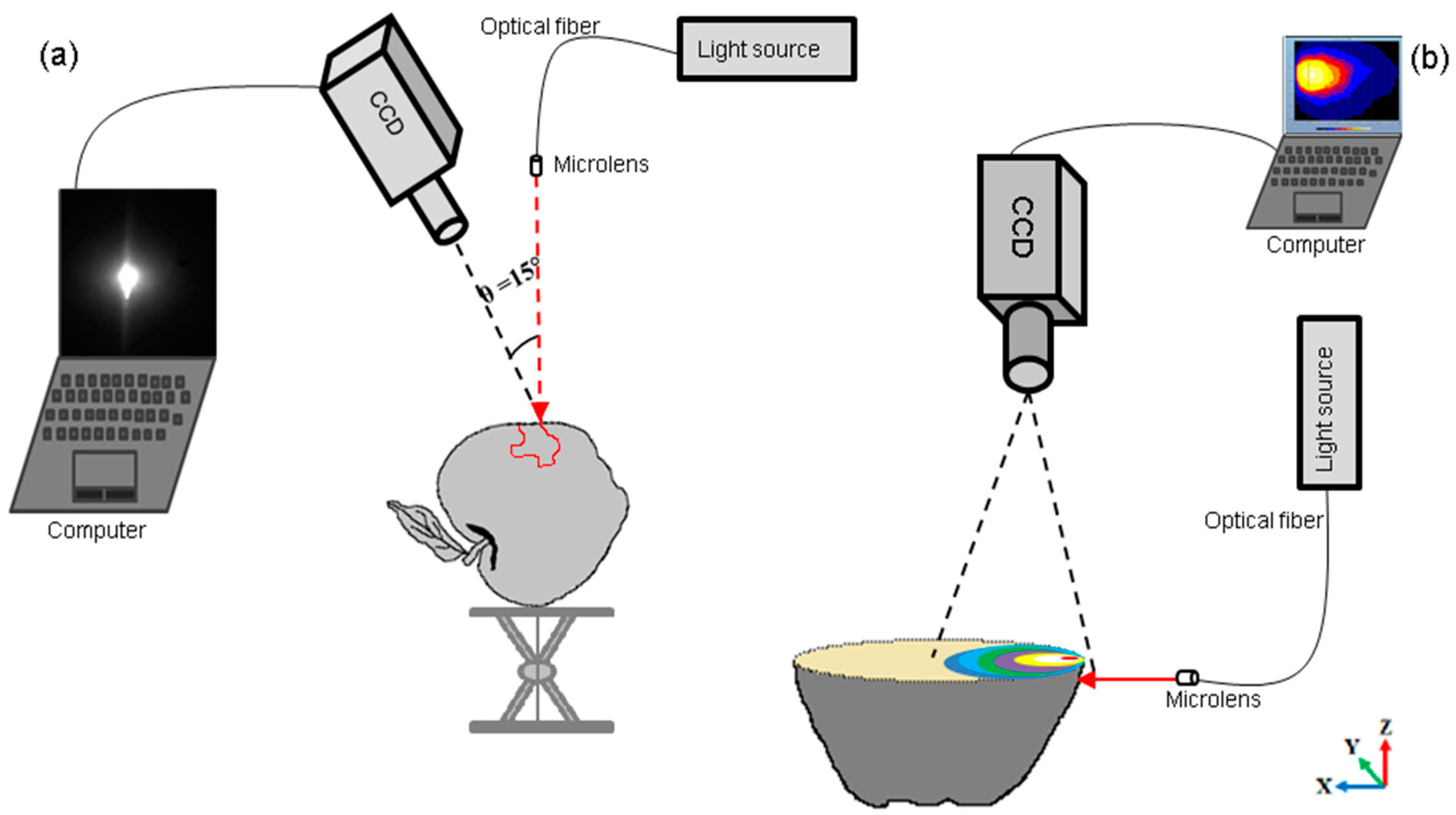


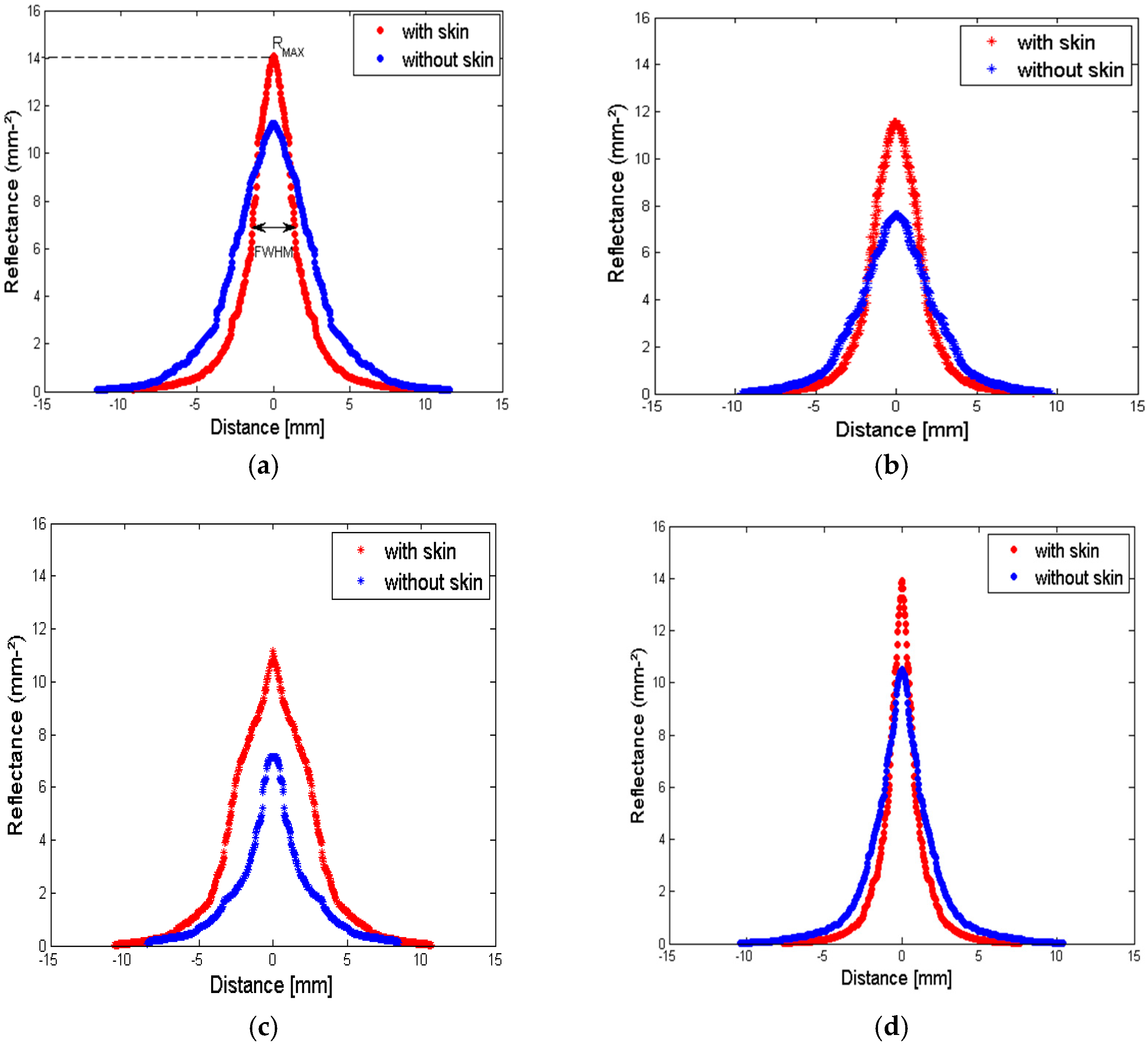
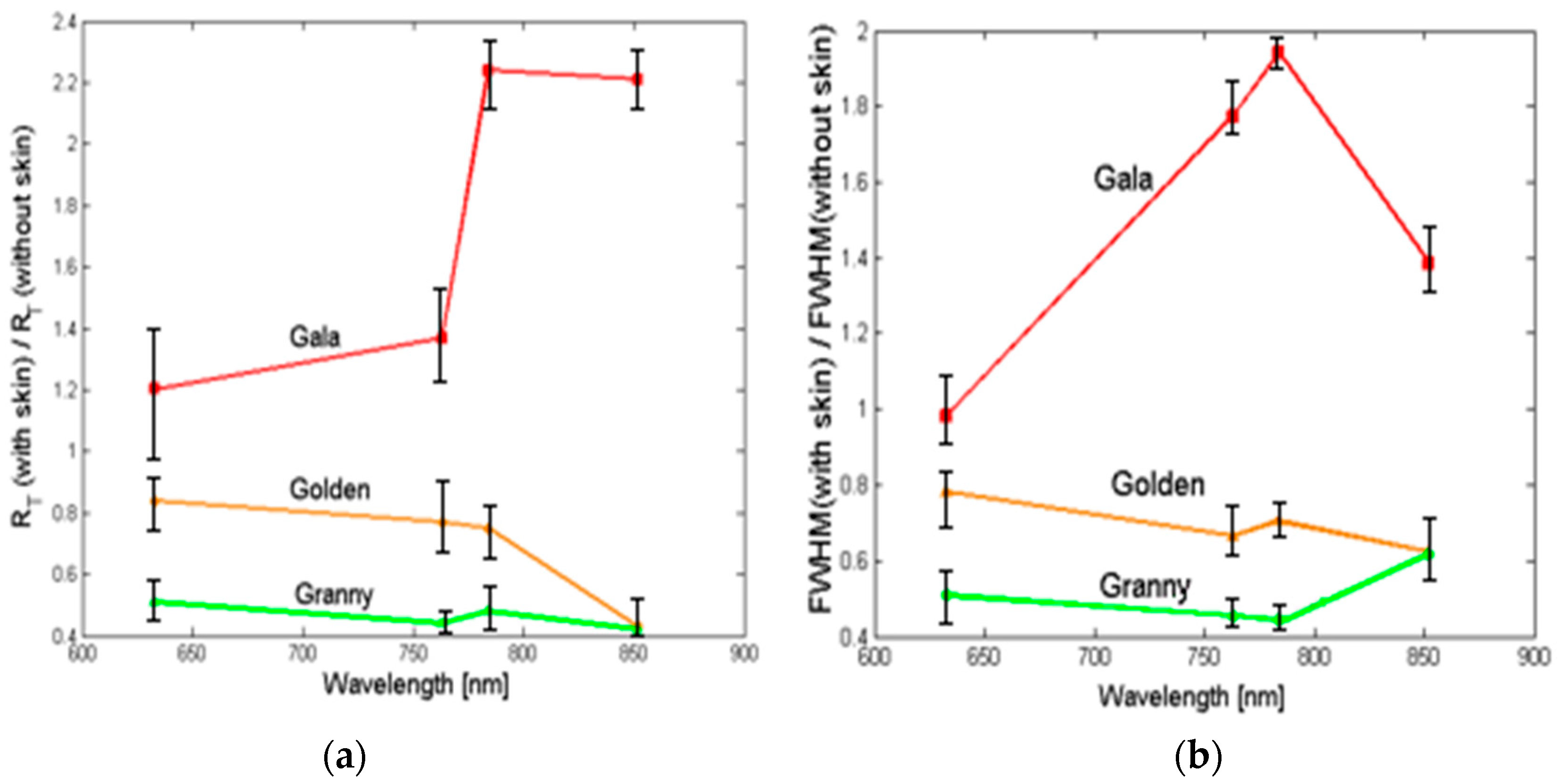
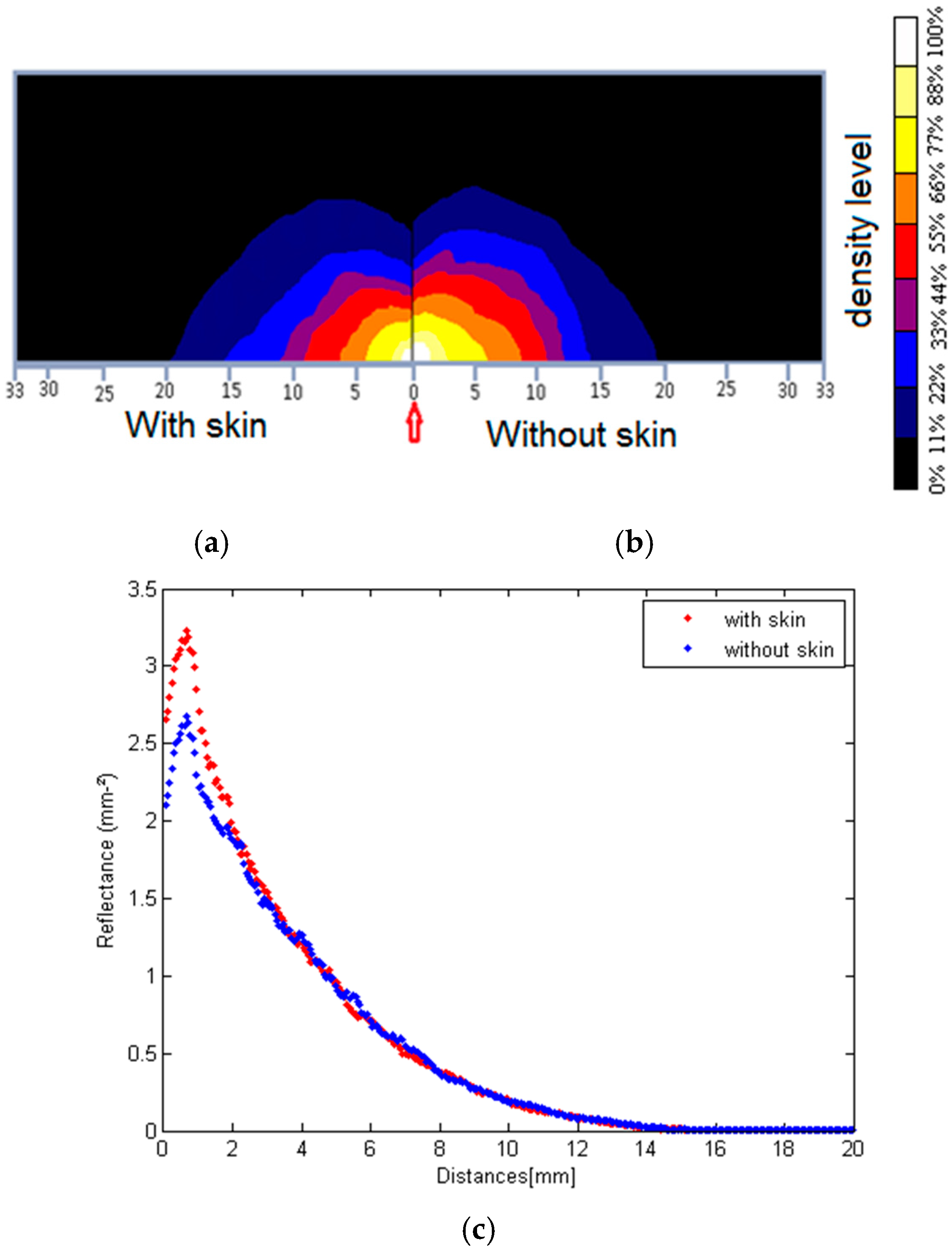
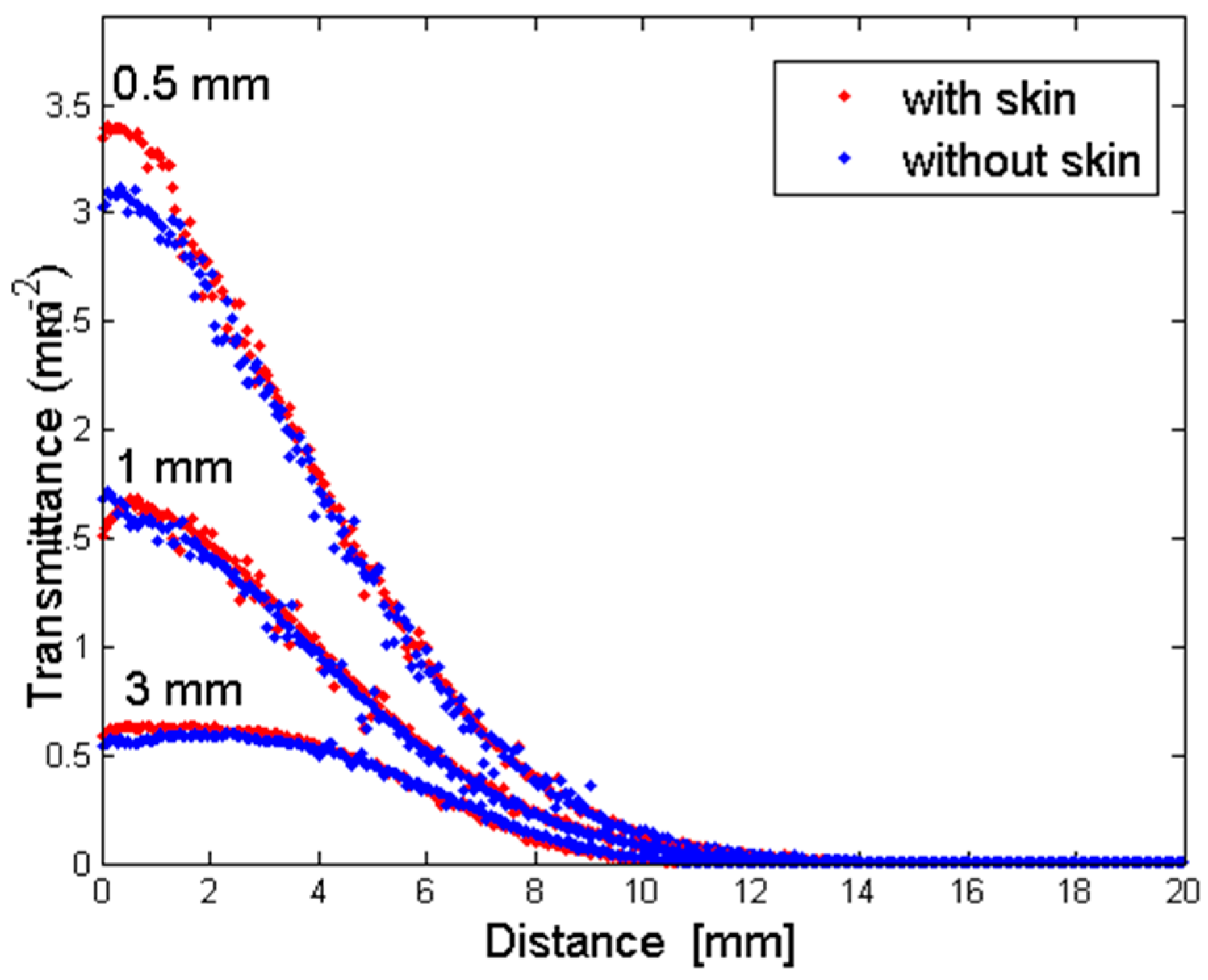
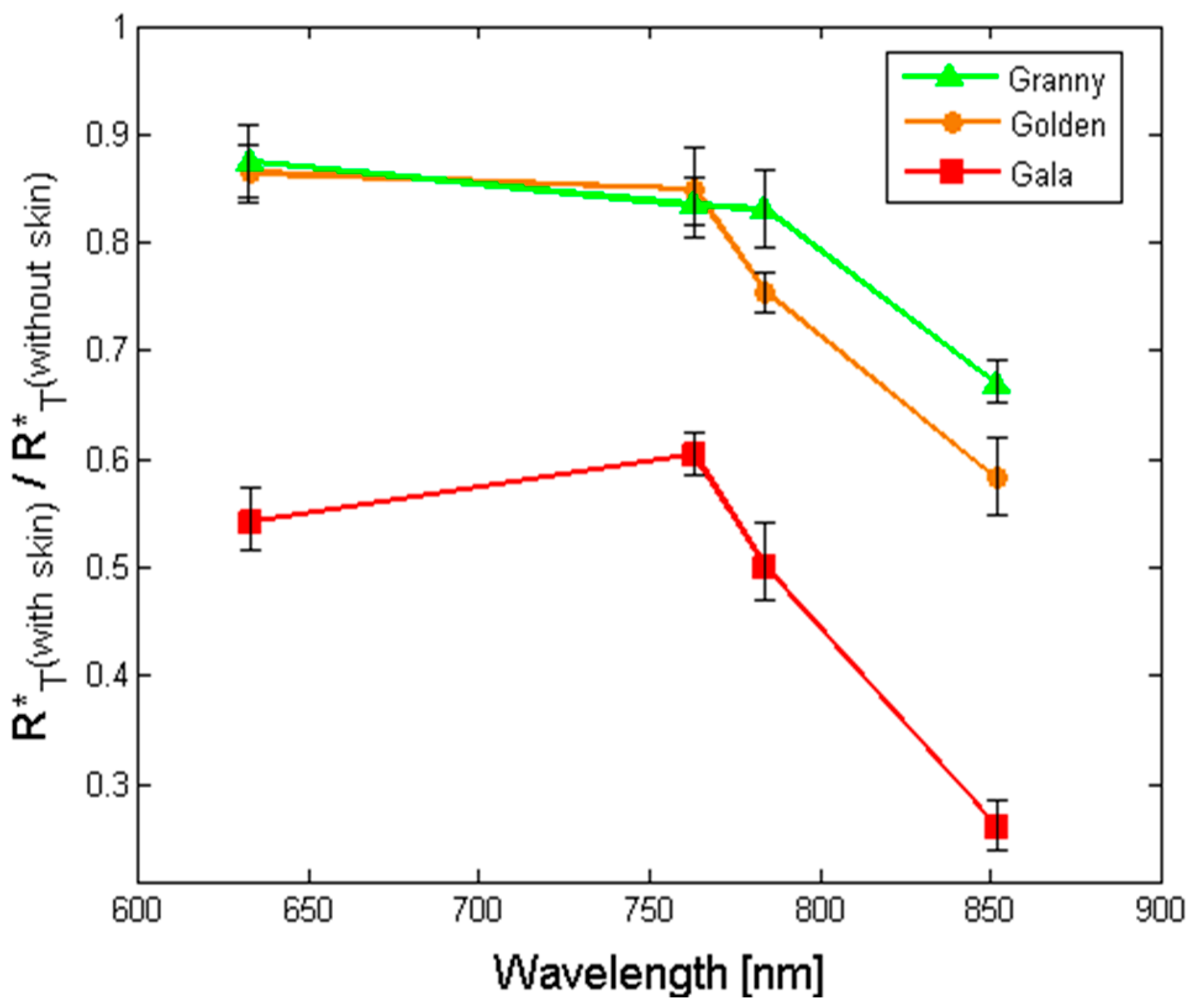
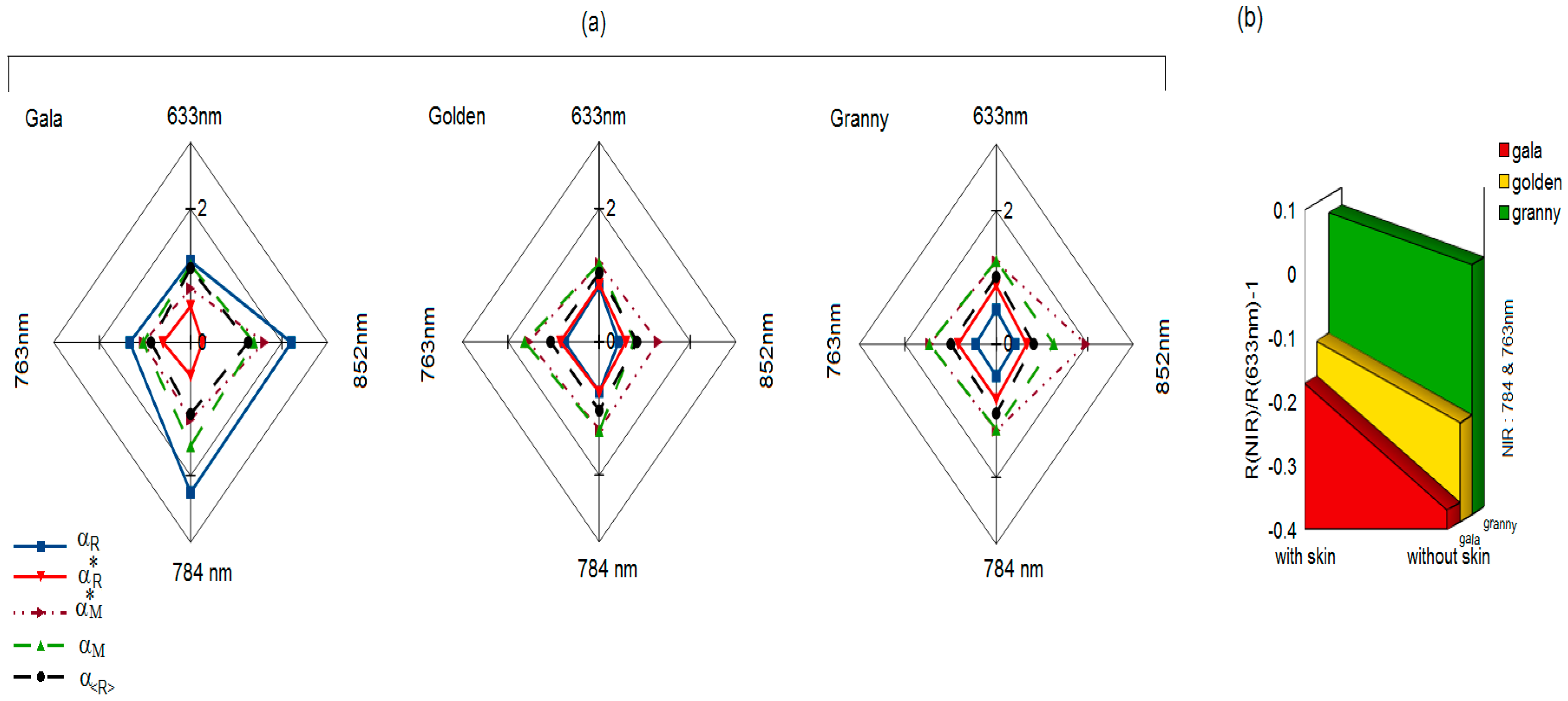
| Apples | 633 nm | 763 nm | 784 nm | 852 nm | ||||
|---|---|---|---|---|---|---|---|---|
| Rmax (mm−2) | FWHM (mm) | Rmax (mm−2) | FWHM (mm) | Rmax (mm−2) | FWHM (mm) | Rmax (mm−2) | FWHM (mm) | |
| Gala_with skin | 12.98 ± 7 a | 6.52 ± 2 a | 09.51 ± 3 a | 3.28 ± 1 a | 11.14 ± 6 a | 5.38 ± 3 a | 13.35 ± 6 a | 4.41 ± 2 a |
| Gala_without skin | 11.18 ± 6 a | 6.64 ± 3 a | 09.15 ± 6 a | 1.85 ± 1 a | 07.16 ± 3 b | 2.77 ± 2 a | 08.69 ± 3 b | 3.18 ± 1 a |
| Granny_with skin | 14.07 ± 3 a | 2.75 ± 1 b | 14.71 ± 8 a | 1.84 ± 1 a | 13.04 ± 6 a | 2.14 ± 1 b | 13.91 ± 6 a | 1.5 ± 1 a |
| Granny_without skin | 11.26 ± 5 b | 5.41 ± 1 a | 10.04 ± 4 a | 4.05 ± 1 a | 10.18 ± 4 b | 4.84 ± 2 a | 11.01 ± 5 a | 2.43 ± 1 a |
| Golden_with skin | 11.78 ± 3 a | 3.23 ± 1 a | 12.47 ± 8 a | 2.87 ± 1 a | 11.25 ± 5 a | 2.61 ± 1 a | 08.13 ± 1 a | 1.69 ± 1 a |
| Golden_without skin | 10.06 ± 5 a | 4.13 ± 2 a | 7.62 ± 4 b | 4.32 ± 1 a | 08.40 ± 6 a | 3.70 ± 1 a | 10.51 ± 5 a | 2.71 ± 1 a |
| λ (nm) | Cultivar | ||||||
|---|---|---|---|---|---|---|---|
| Gala | Golden | Granny | |||||
| μa (mm−1) | μ′s (mm−1) | μa (mm−1) | μ′s (mm−1) | μa (mm−1) | μ′s (mm−1) | ||
| 633 | With skin | 0.0185 a,C,1 | 1.144 a,C,1 | 0.024 a,B,1 | 1.243 a,A,1 | 0.0361 a,A,1 | 1.131 a,B,1 |
| Without skin | 0.0152 b,C,2 | 1.140 a,B,1 | 0.0212 b,B,1 | 1.240 a,A,1 | 0.0275 b,A,1 | 1.125 b,B,1 | |
| 763 | With skin | 0.01582 a,A,4 | 1.082 a,C,2 | 0.0113 a,B,3 | 1.139 a,A,2 | 0.0149 a,AB,3 | 1.101 a,B,2 |
| Without skin | 0.01435 b,B,3 | 1.081 a,C,2 | 0.0085 b,B,3 | 1.132 b,A,2 | 0.0125 b,AB,3 | 1.098 b,B,2 | |
| 784 | With skin | 0.01597 a,A,3 | 1.068 a,B,3 | 0.0091 a,B,4 | 1.125 a,A,3 | 0.0136 a,AB,4 | 1.065 a,B,3 |
| Without skin | 0.01425 b,A,4 | 1.060 a,B,3 | 0.0082 b,B,3 | 1.121 a,A,3 | 0.0121 b,AB,3 | 1.061 a,B,3 | |
| 852 | With skin | 0.01710 a,B,2 | 1.009 a,B,4 | 0.0150 a,C,2 | 1.120 a,A,4 | 0.0188 a,A,2 | 1.018 a,B,4 |
| Without skin | 0.01652 b,B,1 | 0.991 a,C,3 | 0.0137 b,C,2 | 1.118 a,A,4 | 0.01581 b,A,2 | 1.015 a,B,4 | |
© 2016 by the authors; licensee MDPI, Basel, Switzerland. This article is an open access article distributed under the terms and conditions of the Creative Commons Attribution (CC-BY) license (http://creativecommons.org/licenses/by/4.0/).
Share and Cite
Askoura, M.L.; Vaudelle, F.; L’Huillier, J.-P. Experimental Study of Light Propagation in Apple Tissues Using a Multispectral Imaging System. Photonics 2016, 3, 50. https://doi.org/10.3390/photonics3030050
Askoura ML, Vaudelle F, L’Huillier J-P. Experimental Study of Light Propagation in Apple Tissues Using a Multispectral Imaging System. Photonics. 2016; 3(3):50. https://doi.org/10.3390/photonics3030050
Chicago/Turabian StyleAskoura, Mohamed Lamine, Fabrice Vaudelle, and Jean-Pierre L’Huillier. 2016. "Experimental Study of Light Propagation in Apple Tissues Using a Multispectral Imaging System" Photonics 3, no. 3: 50. https://doi.org/10.3390/photonics3030050




